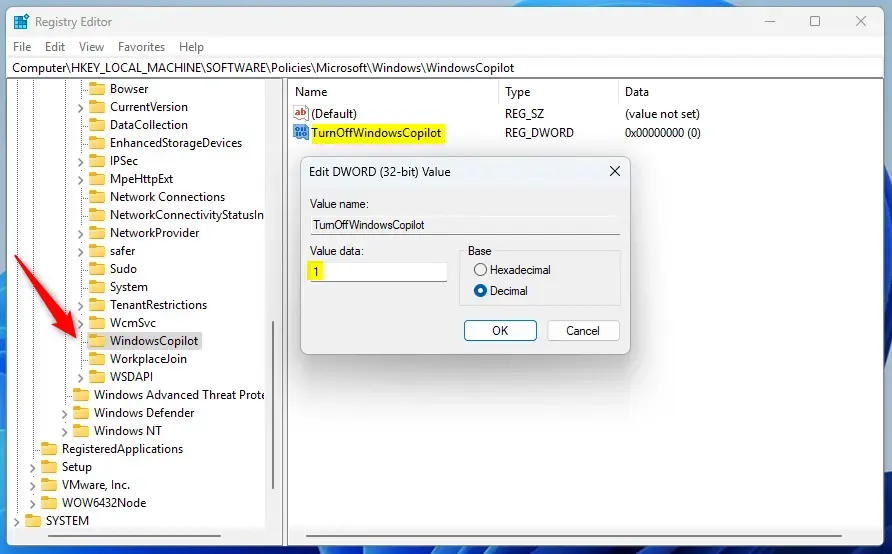This article explains how to disable and remove Copilot in Windows 11.
Copilot in Windows is a generative AI assistance that allows users to interact with the chatbot using natural language to change system settings and work across multiple applications.
For computers that have Copilot added, a new Copilot button will appear on the Taskbar. Clicking the button or using the keyboard shortcut (Windows key + C) will appear as a flyout interface.
Copilot in Windows is currently available as a preview for Windows Insiders only in select locations. Microsoft will continue experimenting with new ideas and methods based on user feedback.
There are various reasons someone might want to remove Copilot from Windows 11. For instance, some users may prefer to use traditional interaction methods with their computer, while others might find the feature distracting or unnecessary.
Additionally, some users may have privacy concerns related to using AI-powered assistance, and they might want to disable Copilot to ensure their data is not being shared without their consent. Whatever the reason, removing Copilot from Windows 11 is straightforward and can be completed in just a few steps.
Disable and remove Copilot in Windows
As mentioned, users can disable and remove Copilot from Windows.
Here’s how to do it.
First, open the Windows Registry and navigate the folder key paths in the User and Computer spaces below.
Computer\HKEY_CURRENT_USER\Software\Policies\Microsoft\Windows\WindowsCopilot Computer\HKEY_LOCAL_MACHINE\SOFTWARE\Policies\Microsoft\Windows\WindowsCopilot
Next, double-click the TurnOffWindowsCopilot (REG_DWORD) names on the Windows Copilot key’s right pane to open it.
Then, enter a value 1 to disable and remove Copilot from Windows.
If you do not see the TurnOffWindowsCopilot item, right-click a blank area and create a new DWORD (32-bit) registry name (TurnOffWindowsCopilot).
Then, enter a value 1

Navigate to these registry keys in the User and Computer spaces.
Computer\HKEY_CURRENT_USER\Software\Policies\Microsoft\Windows\Explorer Computer\HKEY_LOCAL_MACHINE\SOFTWARE\Policies\Microsoft\Windows\Explorer
Next, double-click the DisableSearchBoxSuggestions (REG_DWORD) names on the Explorer key’s right pane to open it.
Then, enter a value 1 to disable and remove Copilot from Windows.
If you do not see the DisableSearchBoxSuggestions item, right-click a blank area and create a new DWORD (32-bit) registry name (DisableSearchBoxSuggestions).
Then, enter a value 1
Navigate to these registry keys in the User and Computer spaces.

Finally, navigate to the registry key below.
HKEY_LOCAL_MACHINE\SOFTWARE\Policies\Microsoft\Edge
Next, double-click the HubsSidebarEnabled (REG_DWORD) names on the Edge key’s right pane to open it.
Then, enter a value 0 to disable and remove Copilot from Windows.
If you do not see the HubsSidebarEnabled item, right-click a blank area and create a new DWORD (32-bit) registry name (HubsSidebarEnabled).
Then, enter a value 0

Delete all the items created above to restore the default behavior and allow Windows Copilot.
TurnOffWindowsCopilot DisableSearchBoxSuggestions HubsSidebarEnabled
Save your changes and restart your computer.
That should do it!
Conclusion:
- Disabling and removing Copilot: This post provided a detailed guide on disabling and removing Copilot from Windows 11, offering users the flexibility to choose their preferred interaction methods with their computers.
- User Privacy: Users concerned about privacy related to AI-powered assistance can use the outlined steps to ensure their data is not shared without consent.
- Feedback and Support: As Copilot is in preview for Windows Insiders, Microsoft continues experimenting based on user feedback, ensuring the feature’s ongoing development aligns with user preferences.
- Further Assistance: Readers are encouraged to use the comments section for support and clarification of any errors or additional information.

Leave a Reply